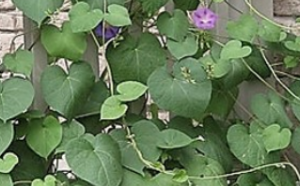“Guilt by association,” is an often-used phase to describe a situation where something is “guilty” because of its association or resemblance to something considered to be bad. For example, for centuries people thought tomato to be poisonous primarily because it is a member of a plant family that contains some very poisonous species. Likewise, morning glory is considered by many to be a weedy plant, since it shares a common name with some plant species that are very difficult to control. As a result, gardeners are reluctant to plant it which is unfortunate, since properly located it can be a very attractive, useful plant.
If a bare fence, empty trellis, or unpleasant view in your landscape seems to need attention, morning glory (or one of its close relatives) might be a solution to the problem. June is not too late to plant morning glory seeds that should develop into a living summer screen. Seeds germinate quickly in warm soils and, with adequate moisture and fertility, plants can cover a trellis sufficiently in about six weeks. This still allows plenty of time for enjoyment before frost.
Morning glory is the common name applied to more than 1000 species of flowering plants belonging to the Convolvulaceae plant family. Ipomoea, the largest and most well-known genus in the family, contains some very attractive species such as Ipomoea purpurea. The latter is just one of several species in the genus that carries the common name of morning glory. The genus name comes from the Greek words ips meaning “worm” and homoios which means “resembling,” and probably makes reference to the twining (worm-like) growth habit of members of this genus.
It should be noted that several troublesome weeds collectively referred to as bindweeds (Convolvulus arvensis and Calystegia sepium) share the common name of “morning glory,” but are very different plants. Bindweed (a perennial) bears leaves are lanceolate-shaped and smaller than the leaves morning glory. In contrast, morning glory is an annual flowering plant whose leaves are large and heart shaped. 
Morning glory plants are vigorous, twining vines. Therefore, in order to climb, the fence or trellis on which they are allowed to grow must be made from materials thin enough for the vines to wrap themselves around. If they are planted next to a board fence or wall, wire or string must be stretched vertically to help the plant move upward. Additionally, morning glories need plenty of bright light. In shady locations they tend to become weak, grow slowly, and do not provide a full, attractive cover.




